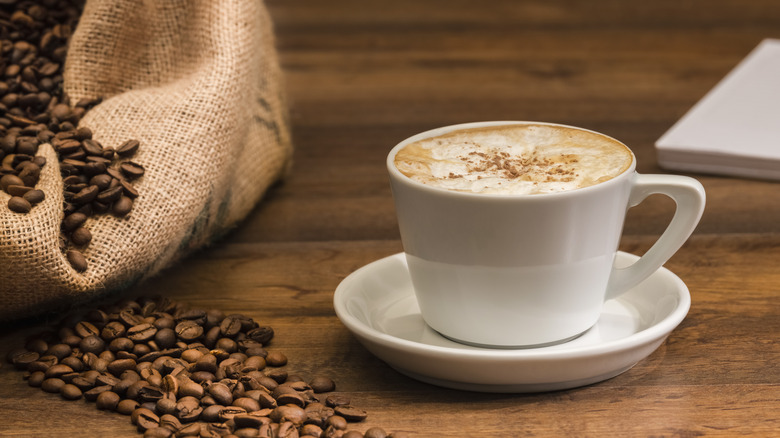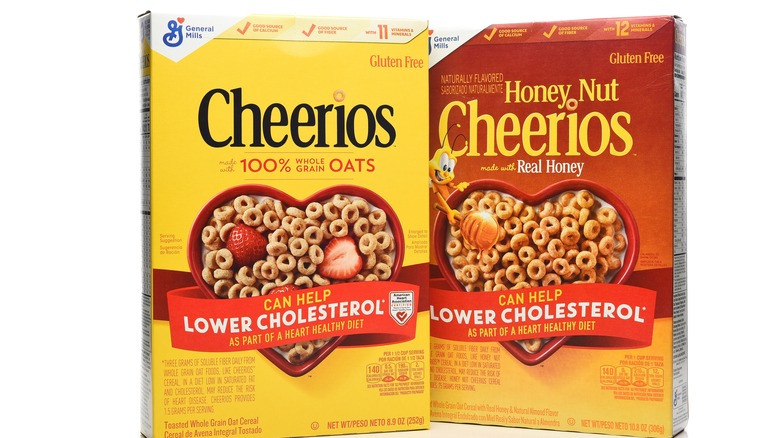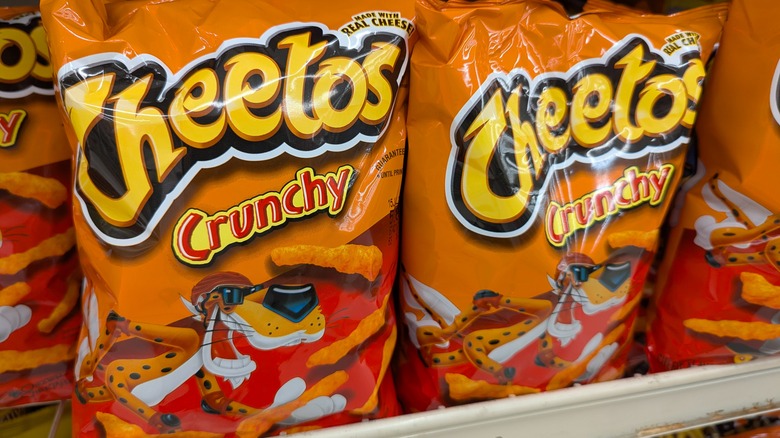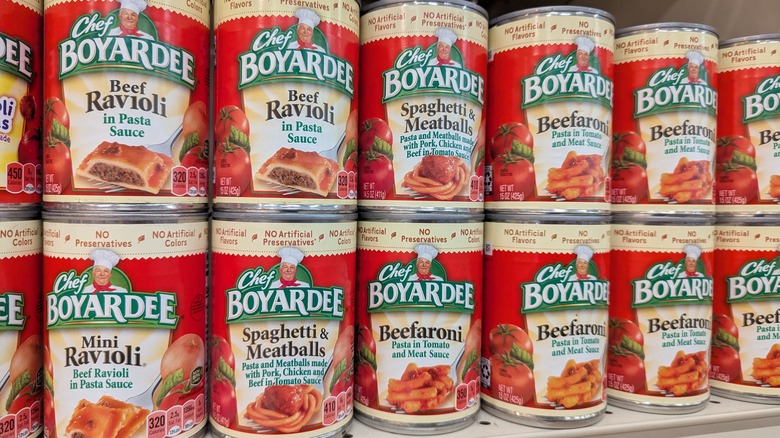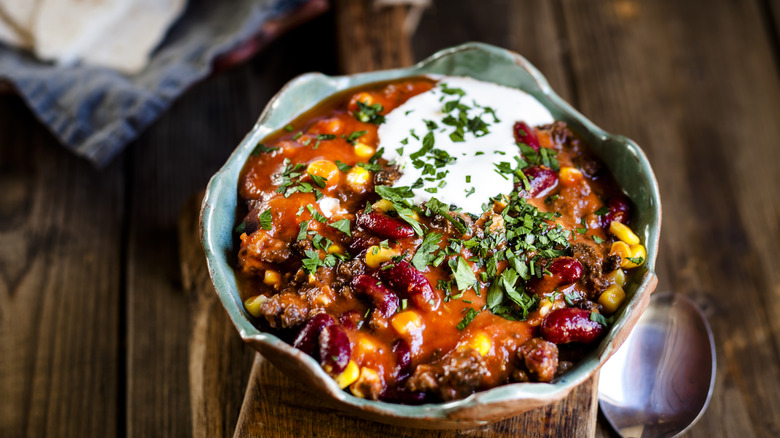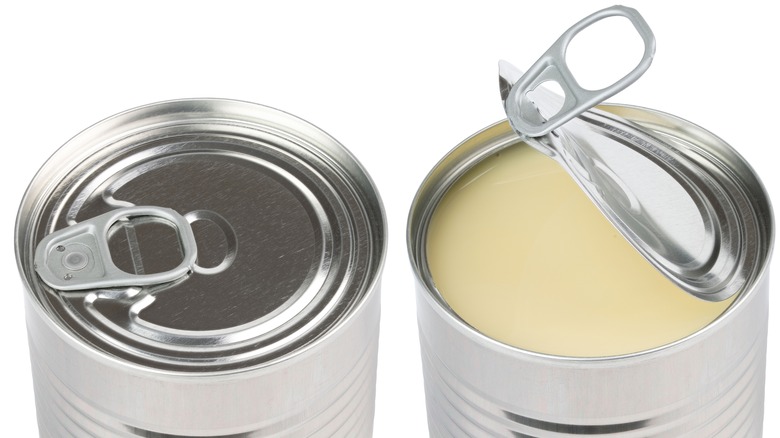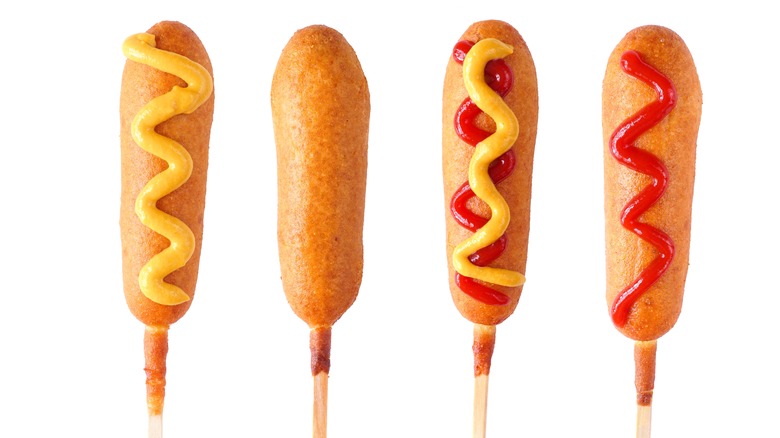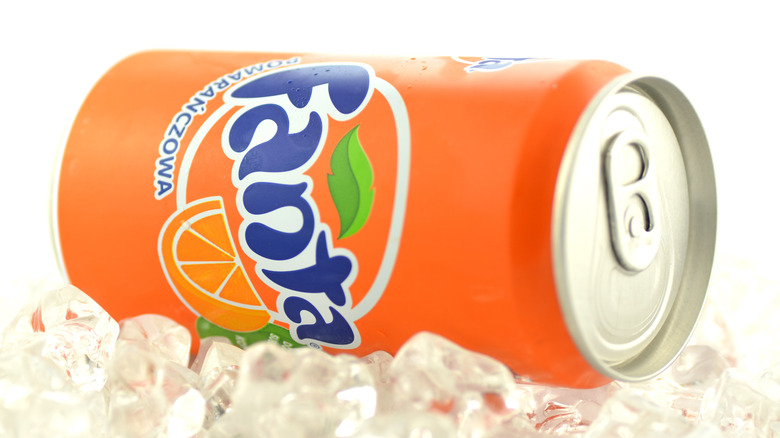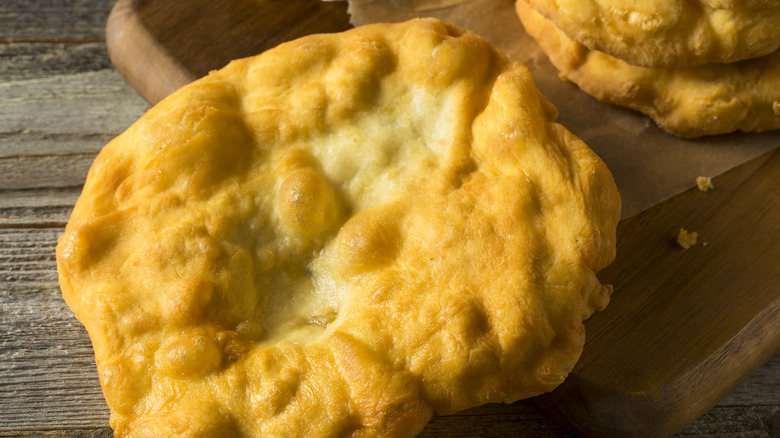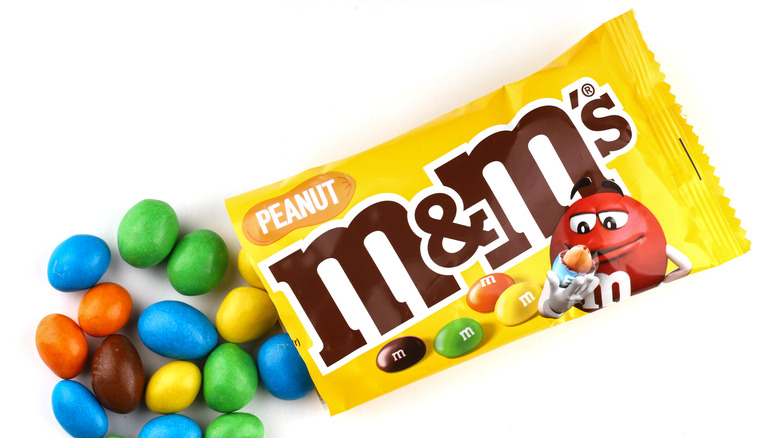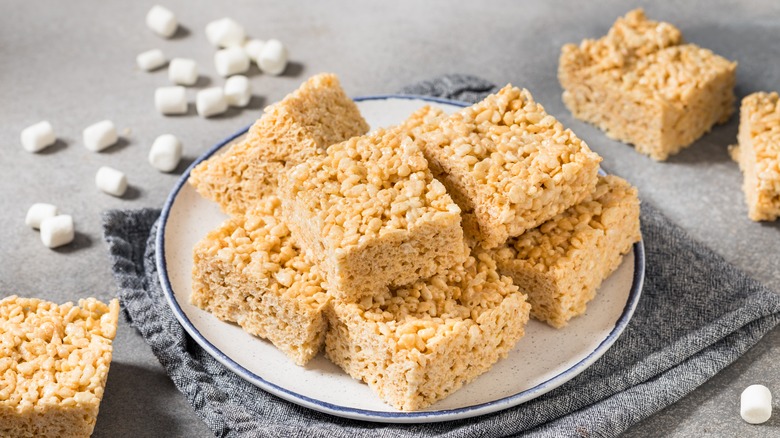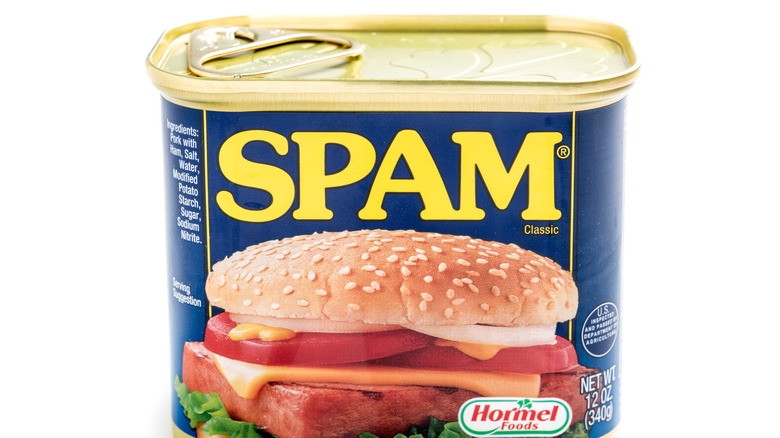13 Old-School Foods You Didn't Know Came From Wartime
The notion of wartime ingenuity likely leads many to think of advancements in transportation, communication, and most especially advanced capabilities in eliminating targets. Be that as it may, no war has ever been fought that without relying on the backs of a nation's armed forces in some fashion. And so it remains that no war has ever been fought without feeding the military. As a result, it has ever been a goal to provide better nutrition to those on the frontlines with expediency, cost efficiency, and shelf stability in mind.
Luckily enough, necessity remains the mother of all invention for cultures, companies, and home cooks alike who have been responsible for incredible breakthroughs, many of which remain commonplace in society today. Whether you're sipping on a cappuccino, refueling between meals with an energy bar, or simply enjoying a handful of M&M's, the list of foods with origins tied to wartime is likely to surprise you.
Cappuccinos
Where coffee itself has become synonymous with commutes to work, late-night study sessions, and a culture of hustling and grinding, the brewed beverage's café cousins are more often associated with sophistication and relaxation. So, it may come as a surprise for some to learn that the espresso-based drink sipped at bistros and bookstores can actually trace its origin back to the battlefield. Specifically, caffeine connoisseurs can thank the Battle of Vienna in 1683. Two months of siege of the Austrian city by the Ottoman Empire would ultimately lead to its loss of territory in Eastern Europe to the Holy League before the end of the 17th century in addition to leaving behind quite a prize.
After the Ottoman forces were driven off, the spoils of war included abandoned bags filled with roasted coffee beans. Locals saw fit to adapt the Turkish preparation more to their liking by sweetening the drink and adding cream as well as an egg yolk, resulting in a color reminiscent of the robes worn by Capuchin friars from the Franciscan order of the Catholic Church. What was then dubbed a Kapuziner would ultimately become known as the cappuccino, but wouldn't begin to rise to the prominence it holds today until the invention of the espresso machine and a steamed milk preparation created in Italy during the World War II era.
Cheerios
Following the Great Depression and the subsequent adoption of President Franklin D. Roosevelt's sweeping New Deal programs, Americans were still reeling through an era of scarcity when World War II began in Europe with Germany's invasion of Poland. Little more than two years later, the attack on Pearl Harbor would bring the United States into the conflict with every person encouraged to do their part toward the war effort. As it happened, before rationing would get underway in America, and after years of making due with forgotten pie flavors worthy of a comeback, a physicist's machine used to puff oat dough would bring about a revolution in breakfast through Cheerios.
Originally sold as Cheerioats when the product launched in May 1941, General Mills had employed physicist Lester Borchardt to create a cereal to compete with Wheaties and Corn Flakes. With bacon and eggs limited, Cheerioats would go on to sell 21 million boxes in its first year alone. By the end of the war, a trademark challenge from Quaker Oats had resulted in a rebrand and the cereal enjoyed by infants and seniors alike, as well as all ages in between, was named Cheerios. Borchardt's machine would later be used to create other popular breakfast cereals including Cocoa Puffs and Trix.
Cheetos
Before orange fingerprints gave certain snacking preferences away, wartime ingenuity needed to collide with visionary innovation and opportunism. Corn puffs had come about as a byproduct of the Flakall company breaking down grains into smaller pieces for livestock with moistened kernels added to the machine in an effort to stave off clogging. When one operator tried seasoning the puffs with salt and cheese, Korn Kurls were born and patented in 1939. However, it was some nine years later that Fritos founder Charles Elmer Doolin would invent Chee-tos with help from the United States military.
In aiming to solve a wartime problem of delivering nutrient dense field to soldiers on the battlefield without spoilage, a method of dehydrating full-fat cheese had been conceived. When the war came to an end, the surplus could not be reconstituted — but it could be repurposed. So it was that Doolin, who himself had been a military supplier, bought up the military's supply of dehydrated cheese and combined it with a cornmeal snack to create what would ultimately become known as Cheetos in 1948.
Chef Boyardee
Cans themselves came as a result of military efforts to preserve food to better supply forces on the move, and — as many have likely heard — they predated the invention of can openers by decades. As innovations continued on improving the practicality of cans, helping consumers avoid using alternative means to open them, so, too, did the military endeavor to improve their contents. This included working with Chef Boyardee through a contract that put the company's Milton, Pennsylvania plant on a round the clock operation to keep up with demand.
Before Ettore Boiardi's brand was put on the map as part of the war effort, the Italian immigrant had catered the wedding reception of President Woodrow Wilson. Within a decade, he'd opened a restaurant in Cleveland, Ohio and those recipes became the start of the now-world famous retail operation. The accolades of being part of the home front enterprise to support soldiers overseas had not only made Chef Boyardee a household name, it also earned Boiardi one of the highest civilian honors at the time in the form of The Gold Star. His efforts to do right by his adopted nation and those who worked to keep up with demand throughout the war found him selling his company shortly thereafter in order to avoid laying off the increased workforce.
Chili
Years before "Remember the Alamo" and "Remember Goliad" became battle cries for Texas independence, Mexico had undertaken its own war of independence in opposition to Spanish rule. The conflicts shared a commonality in fights for control of San Antonio where a Romeo and Juliet-like tale unfolded that was said to have brought the world chili and Tex-Mex restaurants. After Tejano rebels had amassed a force including American soldiers, indigenous peoples, and other fighters to form a Republican Army of the North, success in taking San Antonio was found in April 1813. It was then that the wealthy Louisianan Louis St. Clare fell in love with Jesusita de la Torre, leading her family to be ostracized by the Royalist families.
Facing starvation, but unable to find a property owner willing to provide them space to open a restaurant to support themselves, St. Clare fashioned a table and benches and set up shop with de la Torre and began serving food as the area's first open-air restaurant, considered to the be world's first Tex-Mex establishment. Eventually, St. Clare and de la Torre married and left, but the tradition and the food became a legacy as Chili Queens became a tradition and Tex-Mex became a defined cuisine.
Condensed milk
Ahead of the devastating conflict of the Civil War, inventor Gail Borden had sought to devise a method to make milk a shelf stable product decades before refrigeration would become practical. Toiling away on the problem from his workshop in Brooklyn, New York, Borden's failures paved the way for a breakthrough when he visited a Shaker colony and saw how they used a vacuum pan to boil and dehydrate fruits. Employing the same method on milk to avoid burning it, his success led to a patent, the founding of Eagle Brand, and two unsuccessful attempts to open a factory until his third endeavor in 1864 brought him a lucrative client.
Working with the U.S. government, Borden began providing large orders of sweetened condensed milk as a field ration to the Union Army. Soldiers' favor for the product helped its popularity spread beyond the battlefield, as did the accessibility of dairy free of risk of disease. That came in part thanks to Borden's strict sanitary standards and use of inspectors to all farms from which the company sourced milk. After the turn of the century, the incorporated Borden Condensed Milk Co. would go on to inspire health regulations that continue to this day.
Corn dogs
These days, corn dogs have become a staple of county fairs, sporting events, and even the freezers of many an American home. From a trip through Muskogee, Oklahoma in 1941 where an Illinois hot dog restauranteur tried one baked inside cornbread, to a patent filed in 1927 in Buffalo, New York to prepare deep fried food on a stick, quite a few stories lay claim to the origins of corn dogs. However, their prevalence may have never come to be if it weren't for actions taken to support the war — specifically rationing.
Part of the home front effort during World War II involved limitations on consumption of things like steak. While consumers were limited on how much regular meat they could buy, and places like New York City even instituted Meatless Tuesdays to further restrict sales, the same didn't apply to processed meat, making products like hot dogs fair game. Seeking inventive preparations, The Fletcher family in the Lone Star State was said to have spent months working on a batter recipe for their corn dogs that were introduced at the Texas State Fair in 1942.
Energy bars
In much the same way that canning had made it easier to store and transport meals, and advancements in dehydration had revolutionized getting cheese to the frontlines, efforts at feeding soldiers experienced another breakthrough during World War II. While Tootsie Rolls were already included in ration packs, military research and development sought a better way to make long-lasting rations — and the Hershey Chocolate Corporation was there to help.
After developing the D-Ration Bar, also known as the Logan Bar, that withstood higher temperatures without melting and offered ample calories to keep soldiers fueled, there was still considerable progress to be made in advancing the product. So it was that after the war, research and development continued and the military employed Pillsbury to develop the first intermediate moisture foods (IMF) to be launched into orbit alongside astronauts. Though conserving space and keeping the payload down was critical, NASA's Apollo program still managed to devise a way to make bacon a part of the first meal on the moon. Shortly thereafter, the space age technology that kept solid foods soft became an ideal means to package meal replacement products to the health conscious or those perpetually on the go, and thus the energy bar was born.
Fanta
A testament to the adaptability of marketers in finessing rebrands to reach target demographics, you'd likely never guess the fruit-flavored soft drink that begged the question "Wanta Fanta?" traced its origin back to Nazi Germany. However, that was exactly what happened when shipments of Coca-Cola syrup were halted due to World War II and the German branch of the soda company found itself getting creative to produce a replacement product that was dubbed fantastisch.
Composed out of apple fibers, cider press mash, and leftover whey from cheese production, the original Fanta was similar in color to Coca-Cola and, because of the ingredients, had something of a cheesy flavor to it. Coca-Cola GmbH employee Max Keith, the man who cobbled together the carbonated drink, was said to have been found at a partially destroyed bottling facility still working on production in 1945 as the war came to its end. While Keith lived on and was celebrated at Coca-Cola's Atlanta, Georgia headquarters for keeping the German operation afloat, Fanta in its original form ended with the Nazi regime. Ten years later, Coca-Cola rebranded the beverage in Italy, introducing the well-known orange-flavor which landed in the United States three years later in 1958.
Fry bread
Readily identified today as a Navajo food, fry bread's history is specifically linked to the westward expansion of the United States and years of conflicts between their people and American settlers, as well as the U.S. Army. Much as the Trail of Tears saw members of the Cherokee, Chickasaw, Chocktaw, Muscogee, and Seminole nations relocated, the Long Walk between 1862 and 1864 included the forced relocation of the Navajo to Bosque Redondo in eastern New Mexico along with the Mescalero Apache.
Due to the limited resources along the route, as well as the nature of the land that proved inhospitable to the traditional staples of the Navajo, a new recipe was conceived utilizing the flour, lard, and sugar that had been provided as rations courtesy of the United States government. With the little they had, Navajo women made a dough incorporating the dry ingredients with water before frying them in the lard. Turning hardship into a legacy of resilience, fry bread gained popularity among other native peoples and has since seen myriad adaptations for both savory and sweet cuisines.
M&M's
Prior to the beginning of World War II, the Spanish Civil War pit the Second Spanish Republic against Francisco Franco's Nationalist forces and concluded with his reign until his death. During the conflict, Forrest Mars Sr. observed that soldiers had a supply of chocolates encased in hard shells. Returning to the United States, the son of Mars Company founder Frank C. Mars began a partnership with Bruce Murrie, the son of Hershey Chocolate's president, with an effort to recreate the style of candy that would come to be known as M&M's, after the initials of Mars and Murrie.
By 1941, plain chocolate M&M's were introduced to the world years before the company would see fit to stamp an "m" on the candies to stand out from imitators. Likewise, the brown candy shells wouldn't get a color makeover until the '50s and '60s. Before that, the bite-sized treats made for an easily carried snack for soldiers to keep their calories up during the war much in the same way that the Hershey's D-Ration Bar did.
Rice Krispies Treats
Time and again, scarcity has proven to be the path toward innovation. So it was that Kellogg's recipe tester Mildred Day and her colleague Malitta Jensen were credited with the creation of Rice Krispies treats in the 1930s. While some believed that Day had dreamed up the marshmallow-based snack specifically for a Camp Fire Girls fundraising effort in 1939, Kent Coffman of the Kellogg Co. Archives didn't refute the point on the reason, but detailed that she had in fact originally crafted the sweat treat using molasses and corn syrup much earlier. That recipe had been published on the cereal's packaging in 1932, four years before Day left the company.
As for the way in which Rice Krispies Treats are enjoyed today, the entire Home Economics Department at Kellogg's is credited for the creation that went on to replace the former on packages as America entered World War II. It remained that the popularity of the treats for bake sales played a role in raising funds as has continued to this day — albeit with increasingly creative applications.
SPAM
While the name of this canned meat product has become synonymous with unwanted emails by way of the Monty Python's, Spam was undoubtedly a welcome addition in any G.I.'s supplies during World War II. Introduced in 1937, the name for Spam came courtesy of a Hormel executive's brother, Ken Digneau, who'd been the victor of a $100 contest to that end. The product itself had been developed as a means to sell pork shoulder, a less desirable cut.
Thanks to being a processed meat, those on the home front were free from concern about rations when it came to purchasing Spam. At the same time, those on the frontlines were happy for the myriad uses they came up with in addition to eating the pork product. With over 150 million pounds produced toward aiding the war effort, submissions from consumers had led to the release of a recipe book with 50 different preparations of Spam. Meanwhile, some troops had seen fit to repurpose their canned meat in their own way as lubricant for their guns or as an alternative means to waterproof their boots. These days, Spam has become a beloved part of Hawaiian cuisine and over seven million cans are sold annually in the Aloha State alone.


